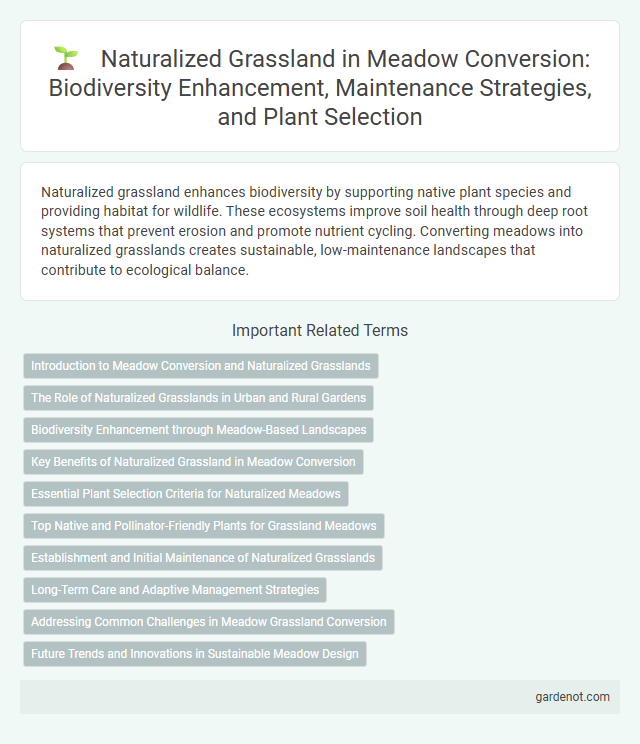Naturalized grassland enhances biodiversity by supporting native plant species and providing habitat for wildlife. These ecosystems improve soil health through deep root systems that prevent erosion and promote nutrient cycling. Converting meadows into naturalized grasslands creates sustainable, low-maintenance landscapes that contribute to ecological balance.
Introduction to Meadow Conversion and Naturalized Grasslands
Meadow conversion transforms managed lawns or agricultural fields into naturalized grasslands, promoting biodiversity and ecological resilience. Naturalized grasslands consist of native grasses, wildflowers, and herbaceous plants adapted to local climates, enhancing habitat for pollinators and wildlife while improving soil health. This ecological restoration practice supports carbon sequestration, water retention, and reduces maintenance compared to traditional turfgrass.
The Role of Naturalized Grasslands in Urban and Rural Gardens
Naturalized grasslands enhance biodiversity by supporting native pollinators and wildlife, contributing to ecological balance in urban and rural gardens. These grasslands require minimal maintenance, reducing the need for irrigation, fertilizers, and pesticides, promoting sustainable gardening practices. Integrating naturalized grasslands into garden landscapes improves soil health and mitigates urban heat island effects, fostering resilient green spaces.
Biodiversity Enhancement through Meadow-Based Landscapes
Naturalized grasslands within meadow-based landscapes significantly enhance biodiversity by providing diverse habitats that support pollinators, birds, and small mammals. These ecosystems promote native plant species richness, which improves soil health and resilience against invasive species. Implementing meadow conversion practices increases ecological connectivity, facilitating species movement and genetic diversity across fragmented landscapes.
Key Benefits of Naturalized Grassland in Meadow Conversion
Naturalized grasslands enhance biodiversity by supporting native flora and fauna, contributing to ecosystem balance in meadow conversion projects. They improve soil structure and water retention, reducing erosion and promoting sustainable land use. These grasslands also offer carbon sequestration benefits, playing a vital role in mitigating climate change while providing aesthetic and recreational value.
Essential Plant Selection Criteria for Naturalized Meadows
Essential plant selection criteria for naturalized meadows prioritize native species with deep root systems to enhance soil stability and water retention. Effective plant choices exhibit drought tolerance, adaptability to local soil conditions, and support biodiversity by providing habitat and food for pollinators and wildlife. Selecting a diverse mix of grasses and wildflowers ensures seasonal interest, resilience against pests, and long-term ecological balance.
Top Native and Pollinator-Friendly Plants for Grassland Meadows
Top native and pollinator-friendly plants for naturalized grassland meadows include species such as Echinacea purpurea (purple coneflower), Asclepias tuberosa (butterfly milkweed), Solidago canadensis (Canada goldenrod), and Silphium integrifolium (rosinweed). These flowering perennials provide essential nectar and pollen resources for bees, butterflies, and other pollinators while thriving in diverse soil conditions. Incorporating a diverse mix of native grasses like Andropogon gerardii (big bluestem) and Schizachyrium scoparium (little bluestem) supports habitat complexity crucial for grassland ecosystems.
Establishment and Initial Maintenance of Naturalized Grasslands
Naturalized grasslands require careful soil preparation and selection of native seed mixes to establish a resilient ecosystem that supports biodiversity and soil health. Initial maintenance involves controlled watering, minimal mowing to encourage deep rooting, and periodic monitoring for invasive species to ensure successful plant establishment. These practices foster a sustainable, self-regenerating grassland that enhances carbon sequestration and promotes habitat for pollinators.
Long-Term Care and Adaptive Management Strategies
Long-term care of naturalized grasslands in meadow conversion involves regular monitoring of species composition, soil health, and invasive species control to maintain ecosystem balance. Adaptive management strategies include adjusting mowing frequency, grazing intensity, and controlled burns based on seasonal growth patterns and environmental feedback. These practices enhance biodiversity, promote native plant resilience, and support sustainable habitat restoration over time.
Addressing Common Challenges in Meadow Grassland Conversion
Naturalized grassland conversion requires overcoming challenges such as soil degradation, invasive species management, and maintaining biodiversity balance. Implementing native seed mixes tailored to local conditions enhances ecosystem resilience and supports pollinator populations. Adaptive management practices, including controlled grazing and periodic monitoring, ensure long-term sustainability and productivity of meadow habitats.
Future Trends and Innovations in Sustainable Meadow Design
Emerging trends in sustainable meadow design emphasize integrating native wildflowers and drought-resistant grasses to enhance biodiversity and carbon sequestration in naturalized grasslands. Advances in remote sensing and AI-driven landscape modeling enable precise monitoring and adaptive management of meadow ecosystems, promoting resilience against climate change. Innovations in seed technology and soil microbiome enhancement further support the development of self-sustaining, low-maintenance naturalized grasslands in urban and rural environments.
Naturalized grassland Infographic

 gardenot.com
gardenot.com